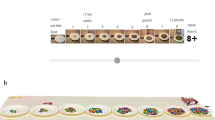Abstract
Objectives: To evaluate the use of a self-administered quantitative food frequency questionnaire (QFFQ) in a national dietary survey concerning (a) response rates with different distribution methods and reward; (b) degree of underreporting of energy intake; (c) reproducibility of the QFFQ; and (d) seasonal variation on reported intake. Design and subjects: A pilot study was performed in 1992 to test response rates to the QFFQ with three different distribution methods, with and without reward, in a random sample of 1200 adults aged 16–79 y. In another study, the QFFQ was distributed to a nation-wide, representative random sample of 5008 adults aged 16–79 y during June, September, November 1993 and March 1994. Reproducibility was evaluated among 90 responders to the survey who answered another QFFQ six weeks later. Results: The distribution method combining postal distribution and collecting the QFFQ by interviewer as well as an offer to participate in a lottery, gave the highest response rate (72%). The possibility to get a reward increased the response rate by 9, 14 and 57%, respectively, depending on the distribution method used. The mean daily energy intake and the percentage of subjects claiming to have unlikely low energy intake did not differ significantly between the different ways of distribution. In the main survey the mean ratio between energy intake and estimated basal metabolic rate was 1.58 among men and 1.47 among women, and 37% of men and 45% of women had a ratio below 1.35. Spearman rank correlations between the two QFFQ ranged from 0.48 (edible fats) to 0.91 (coffee) with a median coefficient of 0.70. For nutrients correlations ranged from 0.55 (carbohydrate E%) to 0.81 (alcohol), with a median coefficient of 0.72. The season of questionnaire administration was of minor importance for the reported intake of the main foods and nutrients. Conclusions: The QFFQ-method is suitable for use in a Norwegian nutritional surveillance system. Sponsorship: National Nutrition Council, Ministry for Agriculture, Ministry for Health and Social Affairs and Norwegian Research Council.
This is a preview of subscription content, access via your institution
Access options
Subscribe to this journal
Receive 12 print issues and online access
$259.00 per year
only $21.58 per issue
Buy this article
- Purchase on Springer Link
- Instant access to full article PDF
Prices may be subject to local taxes which are calculated during checkout
Similar content being viewed by others
Author information
Authors and Affiliations
Rights and permissions
About this article
Cite this article
Johansson, L., Solvoll, K., Opdahl, S. et al. Response rates with different distribution methods and reward, and reproducibility of a quantitative food frequency questionnaire. Eur J Clin Nutr 51, 346–353 (1997). https://doi.org/10.1038/sj.ejcn.1600410
Received:
Revised:
Accepted:
Issue Date:
DOI: https://doi.org/10.1038/sj.ejcn.1600410
Keywords
This article is cited by
-
A meta-analysis of the reproducibility of food frequency questionnaires in nutritional epidemiological studies
International Journal of Behavioral Nutrition and Physical Activity (2021)
-
Means of increasing response rates in a Norwegian dietary survey among infants – results from a pseudo-randomized pilot study
BMC Medical Research Methodology (2019)
-
Biomarkers for nutrient intake with focus on alternative sampling techniques
Genes & Nutrition (2016)
-
Improving response rate and quality of survey data with a scratch lottery ticket incentive
BMC Medical Research Methodology (2012)
-
Alcohol intake and mammographic density in postmenopausal Norwegian women
Breast Cancer Research and Treatment (2012)



